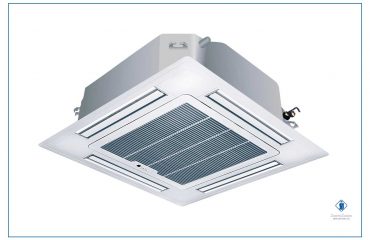Cool air chillers in most brands on the market, especially up to a capacity of 30 tons, have a similar structure. In this article, we examine the components and function of each part and its role in the performance cycle of different types of chillers.
Compressor
The compressor (No. 1) has two functions in the refrigerant cycle. The first function is to remove the gaseous refrigerant from the evaporator and reduce its pressure to such an extent that the tendency to evaporate is still present at that temperature. The second function of the compressor is to increase the pressure of the gas refrigerant to a temperature that is higher than the temperature of the cooling medium available to compress the gas refrigerant.
Cool air condenser
A cool air condenser (No. 2) is a heat exchanger in which the heat absorbed by the refrigerant is transferred to the surrounding air. As soon as the heat of the gas refrigerant, which had high pressure and temperature, is transferred to the environment, its temperature drops until the refrigerant enters the liquid phase. A centrifugal blower or moving fans of an engine create airflow between the condenser.
Pressure limiter
(No. 3) This case protects the system against excessive pressure in the refrigerant circuit.
Barometer to measure the maximum pressure
(No. 4) Provides a visual indication of condensing refrigerant pressure.
Liquid input
This input (No. 5) or receiver is installed to keep the system charged during the process.
Filter dryer
Filter dryer (No. 6) removes moisture, contaminants and other prohibited materials that damage system components and reduce efficiency.
Liquid line solenoid
The liquid line solenoid (No. 7) is an electrically refrigerant flow control valve that closes when the compressor stops operating. This valve prevents the liquid refrigerant from moving towards the evaporator and when the compressor restarts, it causes the liquid to fall. The corrugated liquid can cause severe damage to the compressor. This valve is only open when the compressor is on.
Refrigerant display glass
Refrigerant display glass (No. 8), like an eyepiece, allows the operator to monitor the flow of liquid refrigerant. A sufficient amount of refrigerant is transparent depending on the flow of liquid, and bubbles in the liquid indicate a lack of refrigerant. Meanwhile, the humidity indicator also warns about the ingress of moisture into the system and the need to service the device.
Expansion valve
The operation of the expansion valve (No. 9) is to control the flow of liquid refrigerant into the evaporator at a suitable speed to complete the refrigeration cycle. The more cooling required, the more refrigerant enters the evaporator through the expansion valve.
Hot air side valve
Hot air sub-valve (No. 10) (excluding digital compressors) prevents short compressor cycles by adjusting the compressor thinness. When this part is active, the valve opens and allows the hot refrigerant to enter the stream that flows to the evaporator. This reduces the capacity of the system. Devices that use digital compressors perform internal discharge by means of low-compressor separation plates.
operator
An evaporator (No. 11) is a device in which a liquid refrigerant is boiled, absorbs heat when evaporating, and cools the liquid inside the cycle.
Barometer to measure the minimum pressure
(No. 12) Provides a visual indication of the evaporating refrigerant pressure.
The minimum limit set for refrigerant pressure
(No. 13) protects the system against less than normal pressure in the refrigerant circuit.
Cooling pump
The coolant pump (No. 14) circulates the refrigerant in the system cycle.
Freeze limit
Freeze acetate (No. 15) protects the evaporator from possible freezing. This is an option found on most models.
Processing sensor receiver
This device (No. 16) is placed on the cooling flow path inside the cycle. Control decisions are made based on the temperature of this part.
Cooling barometer
(No. 17) Provides a visual indication of the refrigerant pressure entering and supplying the cycle.
Water supply solenoid
(No. 18) When the float switch is activated, the water supply solenoid opens and enters the relevant tank from the source. This returns the relevant tank to the appropriate operating level.
Float tank level switch
This section (No. 19) is related to the appropriate level of water in the reservoir. If the water level goes below the proper level, the tank float switch will activate the water supply solenoid valve to return the tank water level to a suitable level.
Transmitter sensor sensor
This device (No. 20) is placed on the return path of the cooling flow inside the cycle. Note that this option is only available on LE & HE control tools.
Evaporator current switch
The evaporator current switch (No. 21) protects the system against conditions caused by low cooling current, as it causes damage and operational problems in the system. This is an option found on most models.
Reservoir
The cooling tank (No. 22) is installed to have a sufficient volume and to support the flow needs of the chiller. This tank is not under pressure and works to promote the separation of air and strong currents.
source: https://www.advantageengineering.com/schematics/mkaSchematic.php

 English
English  فارسی
فارسی 



